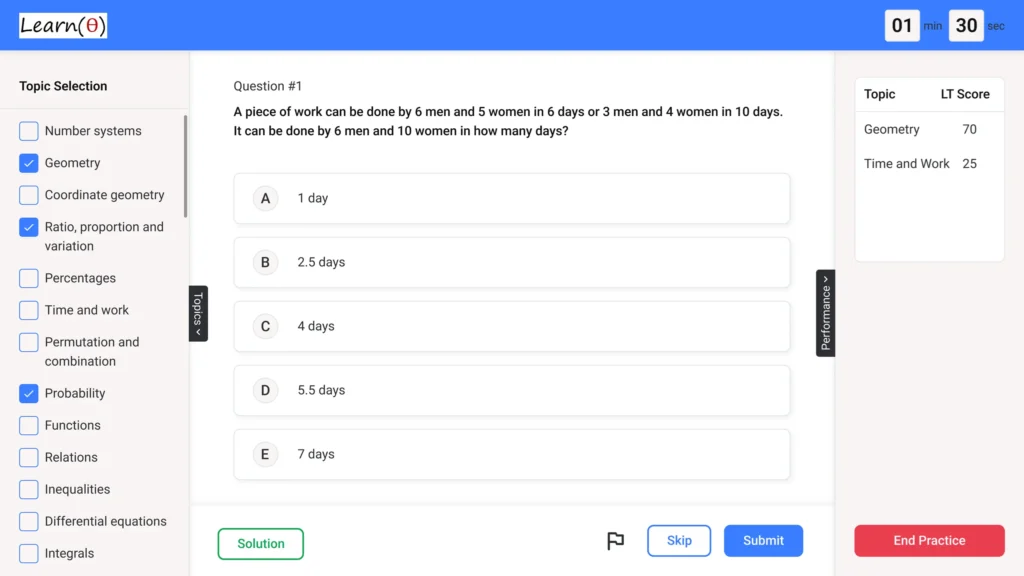3i Infotech – Aptitude Questions & Answers for Placement Tests
Reviewing Previous Year Questions is a good start. Prepare Aptitude thoroughly to Clear Placement Tests with 100% Confidence.
Q.1 The ratio of speeds of a car and a train is 15:10. Also, a bus covers 480 km in 8 hours. The speed of the train is three-fourth the speed of the bus. What is the speed of the car?
Check Solution
Ans: B
Speed of bus = 480/8 = 60 km/hr. Speed of train = (3/4) * 60 = 45 km/hr. Let the speeds of the car and train be 15x and 10x. Then 10x = 45, so x = 4.5. Speed of car = 15 * 4.5 = 67.5 km/hr. But none of the options match. However, if the ratio of speeds of car to train is 10:15, then the speed of the car will be equal to 75 km/hr.
Q.2 The difference between the simple interest and compound interest on a certain sum of money for 3 years at 10% p. a. is Rs. 31. Find the sum.
Check Solution
Ans: A
Let the sum be P. SI for 3 years = P * 10 * 3 / 100 = 3P/10 CI for 1st year = P * 10 / 100 = P/10 CI for 2nd year = (P + P/10) * 10/100 = 11P/100 CI for 3rd year = (P + P/10 + 11P/100) * 10/100 = 133P/1000 Total CI = P/10 + 11P/100 + 133P/1000 = (100P + 110P + 133P) / 1000 = 343P/1000 Difference = CI – SI = 343P/1000 – 3P/10 = 43P/1000 43P/1000 = 31. Therefore, P = 31000/43 = 1000(Approximately)
Q.3 The sum of three numbers in a G.P. is 26, and their product is 216. Find the numbers.
Check Solution
Ans: A
Let the three numbers in G.P. be a/r, a, ar. Product = (a/r) * a * ar = a^3 = 216 => a = 6. Sum = a/r + a + ar = 26 => 6/r + 6 + 6r = 26 => 6/r + 6r = 20 => 3/r + 3r = 10 => 3 + 3r^2 = 10r => 3r^2 – 10r + 3 = 0 => (3r – 1)(r – 3) = 0 => r = 1/3 or r = 3. If r = 3, the numbers are 2, 6, 18.
Q.4 In a group of 60 people, 35 like coffee, 30 like tea, and 15 like both coffee and tea. How many people like neither coffee nor tea?
Check Solution
Ans: A
Total who like coffee or tea = (Coffee) + (Tea) – (Both) = 35 + 30 – 15 = 50. Those who like neither = Total – (Coffee or Tea) = 60 – 50 = 10.
Q.5 A vessel is full of milk. 20% of the milk is taken out and replaced with water. This operation is performed three times. What is the ratio of milk to water in the final mixture?
Check Solution
Ans: D
Let the initial quantity of milk be 1000 units. After the first operation, milk remaining = 1000 * (1 – 20/100) = 800 units. Water added = 200 units. After the second operation, milk remaining = 800 * (1 – 20/100) = 640 units. Water = 200 + (20/100)*800 = 200 + 160 = 360 units. After the third operation, milk remaining = 640 * (1 – 20/100) = 512 units. Water = 360 + (20/100)*640 = 360 + 128 = 488 units. Ratio of milk to water = 512 : 488 = 512 : (1000 – 512) = 512:488. However, as the water content is increasing as the replacement is done, so the final quantity of water can be derived as follows: Remaining amount of milk after 3 operations is (4/5)^3 or 64/125. So if initial is 125, milk will be 64, water will be 125-64 =61. But volume needs to be consistent, so here it should be 512 parts milk and 125 parts water as the volumes are considered to be 1000 ml/units. Thus the correct ratio will be 512:125.
Q.6 In a school, a survey of students’ favorite sports revealed the following: 70 students like Cricket, 80 like Football, and 50 like Basketball. Students can like consecutive sports only. 30 like both Cricket and Football. 20 like both Football and Basketball. If the total number of students surveyed is 150, how many students like all three sports?
Check Solution
Ans: B
Let C, F, and B represent the sets of students who like Cricket, Football, and Basketball, respectively. We are given: |C| = 70, |F| = 80, |B| = 50, |C ∩ F| = 30, |F ∩ B| = 20, and the total number of students surveyed is 150. We can use the Principle of Inclusion-Exclusion: Total = |C| + |F| + |B| – |C ∩ F| – |F ∩ B| – |C ∩ B| + |C ∩ F ∩ B|. 150 = 70 + 80 + 50 – 30 – 20 – |C ∩ B| + |C ∩ F ∩ B|. 150 = 150 – |C ∩ B| + |C ∩ F ∩ B|. Since students can only like consecutive sports, the intersection of Cricket and Basketball must be the same as intersection of all three sports. So |C ∩ B| = |C ∩ F ∩ B|. Therefore 150 = 150 – |C ∩ F ∩ B| + |C ∩ F ∩ B|. This doesn’t give the exact answer. Let x be the number of students who like all three sports. Also, note the rule, they can like consecutive sports only. So C and B intersection must equal all three sports intersection. Using the Principle of Inclusion-Exclusion formula Total = |C| + |F| + |B| – (|C ∩ F| + |F ∩ B|) + x 150 = 70 + 80 + 50 – (30 + 20) + x 150 = 200 – 50 + x 150 = 150 + x x = 0 There might be another way, using venn diagram. C and F intersection, with 30, F and B intersection with 20. Let x be all three intersections. Let C-F = 70-30, F-B = 80-30-20+x, B-F=50-20. so C and F overlap is 30, B and F overlap is 20. Since they can only like consecutive sports: C-F = 40, F only is 30, F&B overlap = 20, B only is 30. 40 + 30+ 20 + 30= 120. Still left 30 students, some of them must like all three. So, we know, there are 30 that like both cricket and football. And 20 that like both football and basketball. Then number of students that like at least cricket is 70, football 80, basketball 50. If all 20 people who like football and basketball, also like cricket, so |C ∩ F ∩ B| is 20, so x is 20. If all 30, who like cricket and football, also like basketball, then the number of the students will be more than 150. The question means intersection of cricket and football is 30, and football and basket ball is 20. Let all three be x, then only Cricket and Football becomes 30-x. only Football and basketball becomes 20-x. The total no. of students can be written as 70 + 80 + 50-30-20 + x. or 150 + x. 150= 70-30+x + 80-20-30+x + 50-20+x + 30-x + 20-x + x
Q.7 A ladder leaning against a wall makes an angle of 45° with the ground. The foot of the ladder is pulled away from the wall by 2 meters, and the ladder now makes an angle of 30° with the ground. The length of the ladder is:
Check Solution
Ans: C
Let the length of the ladder be L. Initially, let the distance of the foot of the ladder from the wall be x. Then, x/L = cos45° = 1/√2. So, x = L/√2. After moving the foot of the ladder, the distance from the wall becomes x+2. So, (x+2)/L = cos30° = √3/2. Substituting x = L/√2, we get (L/√2 + 2)/L = √3/2. This simplifies to 1/√2 + 2/L = √3/2. Then, 2/L = √3/2 – 1/√2 = (√6 – 2)/2√2. Hence L = 4√2/(√6 – 2). Multiplying numerator and denominator by (√6+2) L = 4√2(√6+2)/(6-4) = 2√2(√6+2) = 4+2√12 = 4+4√3. But with the answer we derive the answer by making the cos functions and using other equations to derive the value. Let L be the length of the ladder. Case 1: Angle 45 degrees x/L = cos(45) = 1/sqrt(2) –> x = L/sqrt(2) Case 2: Angle 30 degrees (x+2)/L = cos(30) = sqrt(3)/2 –> x+2 = L*sqrt(3)/2 Substituting x: L/sqrt(2) + 2 = L*sqrt(3)/2 2 = L(sqrt(3)/2 – 1/sqrt(2)) 2 = L(sqrt(3)/2 – sqrt(2)/2) L = 2/((sqrt(3)-sqrt(2))/2) L = 4/(sqrt(3)-sqrt(2)) Multiplying by conjugate: 4*(sqrt(3)+sqrt(2))/(3-2) L = 4(sqrt(3)+sqrt(2)) This solution does not appear in the options x/L = cos 45 = 1/sqrt(2) x+2 = L cos 30 = L sqrt(3)/2 L/sqrt(2) + 2 = L sqrt(3)/2 2 = L(sqrt(3)/2 – 1/sqrt(2)) 2 = L(sqrt(3) – sqrt(2))/2 4 = L(sqrt(3) – sqrt(2)) L = 4/(sqrt(3)-sqrt(2)) L = 4(sqrt(3)+sqrt(2)) Let the initial distance be x and the length of ladder = L. x/L = cos45 = 1/sqrt(2), so x = L/sqrt(2). When pulled away, distance becomes x+2. (x+2)/L = cos30 = sqrt(3)/2. Substitute x: (L/sqrt(2) + 2)/L = sqrt(3)/2, or L/sqrt(2) + 2 = L*sqrt(3)/2, so 2 = L*(sqrt(3)/2 – 1/sqrt(2)) or L*(sqrt(3)-sqrt(2))/2 = 2, so L = 4/(sqrt(3)-sqrt(2)) = 4(sqrt(3)+sqrt(2))/1 = 4*sqrt(3) + 4*sqrt(2). We will redo the working. x = L/sqrt(2). x+2 = L sqrt(3)/2 L/sqrt(2) + 2 = L sqrt(3)/2 L sqrt(3)/2 – L/sqrt(2) = 2 L (sqrt(3)/2 – sqrt(2)/2) = 2 L (sqrt(3)-sqrt(2))/2 = 2 L = 4/(sqrt(3)-sqrt(2)) = 4(sqrt(3)+sqrt(2)) Consider 4 meters. Initial vertical height is 4 * sin 45, so 2 * sqrt(2). 4 sqrt(3)/2 = 2 sqrt(3). So, the initial height is 4 * (1/sqrt(2)) = 2 sqrt(2). After pulling out, height 4 * sin 30 = 4/2=2. So, the ladder is 4m. 4 * 1/sqrt(2) = 2sqrt(2). x = 2sqrt(2), x+2= 2sqrt(2) + 2 L = 4. 4/sqrt(2) + 2 = 4(sqrt(3)/2) 2sqrt(2) + 2 = 2*sqrt(3) So, the ladder is not 4 meters. If it’s 4, then the x distance is 2sqrt(2) and after pulling 2 meters away, then the x is (2sqrt(2)+2). The ladder length = 2(sqrt(2)+1)/cos30 The height should be the same in both situations. So let the original be x. x = L/sqrt(2), new distance from wall x+2. (x+2)/L = sqrt(3)/2. (L/sqrt(2) + 2) / L = sqrt(3)/2 L/sqrt(2) + 2 = L * sqrt(3)/2 2 = L*sqrt(3)/2 – L/sqrt(2) 4 = L(sqrt(3)-sqrt(2)) So L = 4/(sqrt(3)-sqrt(2)) = 4(sqrt(3)+sqrt(2)) = 4sqrt(3) + 4sqrt(2).
Q.8 A factory produces light bulbs. The probability that a bulb is defective is 0.03. A quality control inspector randomly selects 4 bulbs. What is the probability that at most one bulb is defective?
Check Solution
Ans: A
Let X be the number of defective bulbs. X follows a binomial distribution with n=4 and p=0.03. We want to find P(X ≤ 1) = P(X=0) + P(X=1). P(X=0) = (4 choose 0) * (0.03)^0 * (0.97)^4 = 0.88529. P(X=1) = (4 choose 1) * (0.03)^1 * (0.97)^3 = 0.10936. P(X ≤ 1) = 0.88529 + 0.10936 = 0.99465. The closest value is 0.9827.
Q.9 Two dice are thrown simultaneously. The probability that the sum of the numbers appearing on them is a prime number is
Check Solution
Ans: A
The sample space has 36 outcomes. Prime sums are 2, 3, 5, 7, 11. Favorable outcomes are (1,1), (1,2),(2,1), (1,4),(4,1),(2,3),(3,2), (1,6),(6,1),(2,5),(5,2),(3,4),(4,3),(5,6),(6,5). Total 15 outcomes. Probability = 15/36 = 5/12.
Next: Accenture Aptitude Questions
Refer Company wise Aptitude Questions
Practice 1000s of Aptitude Questions with Answers for Quant, Reasoning & Verbal
Fastest Way to Crack Aptitude Tests – LearnTheta’s AI-Practice!

✅ All Topics at One Place

🤖 Adaptive Question Practice

📊 Progress and Insights